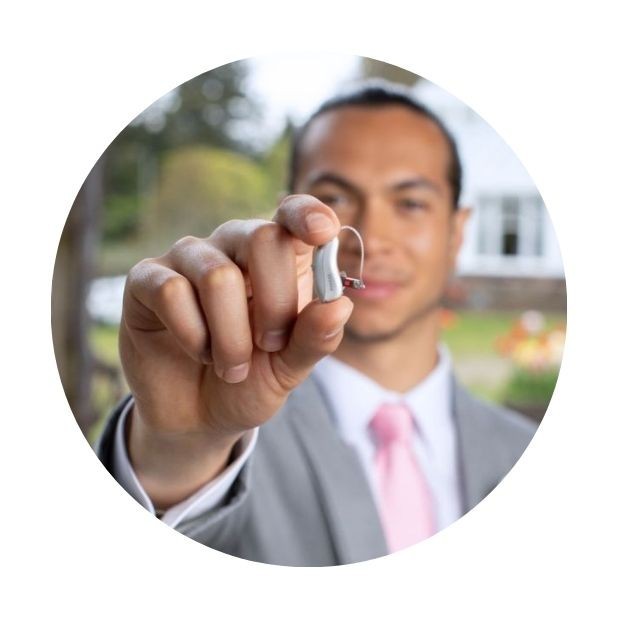Free home visits
with a local audiologist

Replacing hearing aids can significantly enhance your hearing experience. Newer models offer advanced technology, improved sound quality, and better comfort. Whether upgrading for better performance, replacing lost devices, or addressing changes in your hearing, choosing the right replacement can make a world of difference, helping you reconnect with the sounds around you.
Hearing aid devices can be small and discreet - especially some ITE models - and are commonly lost. Losing something valuable to us is one of life’s vexes. Chances are we’ve all had episodes of misplacing car keys, jewellery and mobile phones. You might have even had the unfortunate experience of losing a hearing aid in the past.
Digital hearing aids are commonly one of the most expensive devices and investments we own and need every day. This is why we must do everything we can to keep them safe and regularly carry out maintenance checks to keep them in optimum shape and performance.
If you have lost a hearing aid, we hope that this article will help, as we focus on some brief tips to assist you in hearing at your best again.
We also cover what to do if you need replacement hearing aids and other hearing aid troubleshooting problems such as:

Like other complex technologies, we upgrade when we feel that there are better and more advanced devices out there on the market. Hearing aids are no different and it is important to know when to think about upgrading yours.
As a rule of thumb, hearing aids need to be upgraded every few years - usually around 3 or four - due to many reasons, not just because your old devices can't be repaired. Consider replacing your hearing aids if:
Our hearing changes just like our eyes do and over time you'll realise that your hearing aids aren't powerful enough to assist you. You'll notice this deterioration especially if your hearing alters and becomes more profound and you are currently wearing hearing aids for mild to moderate hearing loss. This is when your hearing will be supported more beneficially with power aids.
Health changes can also be a reason why you should think about replacing your existing hearing aids. This is generally a dexterity issue, as often people who contract arthritis in their hands can make putting in ITE hearing aids very difficult.
You might also struggle to put in and take out batteries. This is when BTE hearing aid styles might be better suited to your new needs - or even rechargeable hearing aids - when battery replacement isn't needed.
As we stated earlier, hearing aids should be replaced around every four years. So if your hearing aids are older than that - consider an appointment with your audiologist to discuss other more advanced options.
The reason for this is, usually, between three and seven years is the life span of hearing aids. You wear them every day and naturally, they go through a lot of wear and tear. They are constantly working and connecting and adjusting to help you to hear better. Regular maintenance does help keep your hearing aids going, but it is the new technology that makes the difference.
For instance, your older hearing aids simply won't deliver the best hearing performance for you as a newer device on the market. Technology is continuously being modernised - offering more efficiency, refined listening experiences and more.
There are many hearing aids today that incorporate artificial intelligence, so they are constantly learning about your hearing specifications and adjusting automatically. Another hearing aid breakthrough is the use of motion sensors within aids. These are designed to understand and adapt based on your movements, so you always hear at your best wherever you are.
Modern hearing aids are offering great technology as standard in today's market, which you are not benefiting from with your current aids. Newer hearing aids will likely be able to...
You might have adapted to a life that is more active and now need your hearing aids to keep up. Alternatively, you aren't as active as you used to be and may need a simpler model that is less complicated.
When you originally purchased your hearing aids, you might have got a more basic model because it felt new and too complex a device. You might now feel more confident in wearing your hearing aids and have found that you would like to tap into more connectivity and advanced features that modern hearing aids can provide.
Or you have a better idea of what you want and perhaps your priorities have changed. For instance, the universal connectivity of Phonak Paradise hearing aids or the artificial intelligence seen in Oticon More might now sound more appealing than a basic model. Consumer expectations are growing and with it, technology has had to adapt and bring out new worlds first, which offer you and your hearing loss more.

Your local audiologist will go through the features you are benefitting already from your hearing aids, and what works well and what doesn't work as well. They will show you what is now on offer and how these advancements can complement your hearing and lifestyle.
They will go through every step of how to use your hearing aids, so you always get the most out of them. You should never leave a fitting appointment without good knowledge of your new devices. Your audiologist will also make any adjustments needed in your follow-up appointment - based on your hearing needs and how you've adapted to your new aids.
NHS hearing aids are free and provided on a long-term loan basis, therefore you don't own your hearing aids. Repairs and batteries are also free, but you will be charged if you damage or lose your hearing aids.
The main process for claiming lost or stolen hearing aids is to contact your insurance provider and they will first explain the process to you in detail and then support you in receiving your replacement hearing aids. The cost you will need to cover would all depend on your insurance policy and the excess you agreed to.
So, is a hearing aid warranty or hearing aid insurance worth it? Whilst some people can get their digital hearing aids covered under their household insurance, many insurance companies these days either don’t offer this or can charge a hefty premium to do so.
Some people are also concerned that they may lose their no-claims discount on their household insurance should they need to make a claim. Due to this, we as a company, give hearing aid wearers more flexibility around this issue, we now offer two options: hearing aid insurance and hearing aid warranty. You can learn more about the differences here

Putting labels on all hearing aid boxes and cases: A lot of technology has very similar casings and it is sometimes very easy to get them mixed up.
Some of our patients use glow-in-the-dark stickers, just in case they need to locate their hearing aids and other technology items in the dark.
Use your hearing aid case: All hearing aids should come with a case or pouch, which is ideal for travelling or for keeping your devices safe and out of reach when not using them.
Keep them out of reach and at eye level: If you have any pets or children/grandchildren, it is advised that you keep your hearing aids out of reach.
Take care when removing your hearing aids: Try not to take out your hearing aids in public or during social events as the chances of losing them or much higher and the chances you'll find them are considerably lower.
If you have to remove them for whatever reason, ensure you remove them slowly, put them in a hearing aid case and store them safely.

Losing hearing aids can be a frustrating and inconvenient experience, especially if you rely on them to hear and communicate effectively. If you have lost your hearing aids, there are a few steps you can take to try to find them:
If you are unable to locate your hearing aids, you may need to replace them. It is important to talk to a qualified hearing healthcare professional to find the best options for your needs and budget.
In the meantime, you can use assistive listening devices or other alternatives to help you hear while you are waiting to get new hearing aids. Call us free on 0800 567 7621 to talk to an audiologist who can support you with hearing loss, hearing aid upgrades, hearing tests and other hearing healthcare guidance.
Do not spend hundreds of pounds without getting a second opinion from us.
 Not only are the prices great, but the service is fantastic! Many thanks to your team.
Not only are the prices great, but the service is fantastic! Many thanks to your team.When we refer to a product as 'Latest Launch', we mean it is the latest to be released on the market.
When we refer to a product as 'New', we mean that the product is the newest hearing aid model on the market.
When we refer to a product as 'Superseded', we mean that there is a newer range available which replaces and improves on this product.
When we refer to a product as an 'Older Model', we mean that it is has been superseded by at least two more recent hearing aid ranges.